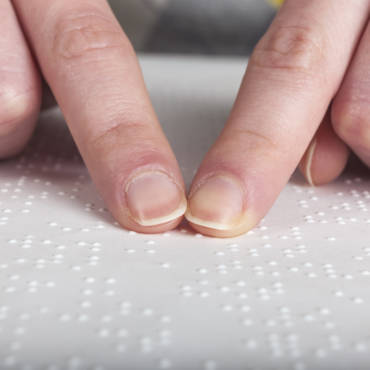Blindness and House Hunting – National Braille Literacy Month

January is Braille Literacy Month, in honor of the birthday of Louis Braille, who created a system of printing, reading, and writing for the blind in 1824, that we all know now as Braille. According to the CDC, approximately 12 million people 40 years and over in the United States have vision impairment; this includes people who are blind, have vision impairment after correction, and vision impairment due to uncorrected refractive error. As a real estate professional, it’s important to know how to properly take care of and be inclusive to clients with blindness or visual impairments. We’ve compiled some tips on how to take good care of your visually impaired real estate clients.
If you’ve never worked with a visually impaired client, you may struggle to think of how to provide a satisfying home viewing. But remember- sight is just one of our five senses. Try to challenge yourself to be aware of your other senses such as touch, smell, and sound when exploring a home. As a real estate professional with full sight, these may be things you easily look past, but to a visually impaired client, these will be some of the first things they notice.
The three A’s: Approach, Ask, Assist.
When first meeting with a blind or visually impaired client, the three A’s come in handy to make a good first impression. The three A’s are as follows:
Approach: If you suspect someone may need a hand, greet them by name so they know you are speaking to them, then identify yourself so they know who they are speaking to.
Ask: Extend your offer to help. The person will either accept your offer or tell you they don’t require assistance.
Assist: Listen carefully to the reply and assist as requested. Not all people who are blind or vision impaired will want or need your assistance. Don’t be personally offended if your assistance is not required.
Housing Priorities
When working with a blind or visually impaired client, start by conducting a thorough exploration of their housing priorities before anything else. Ask the client to be specific about their needs and what a comfortable living situation looks like for them. Some examples would be access to public transportation, the natural and added light to a home, and accessibility around the home. Finding out what is the hardest part of your client’s day will give you immediate direction. Be prepared for your visually impaired clients to want or need you to describe home features in great detail, explore the walls and door openings of the home, or stand in the center of a room clapping or making a clicking sound to hear the contours of the space. In addition, if you post listings on your website, make sure you are including audio descriptions for blind and visually impaired clients.
Paperwork
When it comes down to paperwork, make sure your client is accommodated properly. The best way to assist a client who is blind or visually impaired is to have a trusted family member or friend sit down with the client and yourself to go over each and every document in the transaction well before any due dates to ensure they have ample time. It’s important that your client fully understands the contents of all documents that are signed, dated, and initialed in a real estate transaction. As a real estate professional, it is your fiduciary duty to give your client your utmost care, honesty, and place the interests of your client above your own.
At the end of the day, a blind or visually impaired client is like every other client, and they should be treated as such. Shaking your client’s hand, making eye contact, speaking to them by name and being respectful will always be standard. We hope this encourages real estate professionals to become more educated, aware, and more inclusive to blind and visually impaired real estate clients in their practices.




